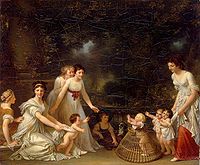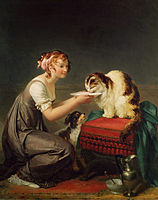Marguerite Gérard
Marguerite Gérard | |
|---|---|
 Marguerite Gérard, by François Dumont | |
| Born | 28 January 1761[1] |
| Died | 18 May 1837 (aged 76) Paris, Kingdom of France |
| Nationality | French |
| Known for | painting, etching |
| Style | Genre art |
Marguerite Gérard (28 January 1761 in
Biography
Upon the death of her mother in 1775, Marguerite Gérard, the youngest of the seven children, took up residence in the
Her association with Fragonard's circle allowed Gérard the freedom to remain unmarried without becoming a financial burden to herself and her parents; this allowed her to devote her life to becoming an artist, a career she continued with considerable commercial success for more than fifty years.[3][5] Speculation that Gérard and Fragonard were lovers has been thoroughly disproved, and Gérard referred to the older artist as a father figure.[3] After the death of Fragonard she continued to live with her sister for 17 years.[3]
Art production
Gérard became interested in art while living with her sister, Marie-Anne Fragonard, and brother-in-law, Jean-Honoré Fragonard, in Paris. She aspired to become an artist like her sister, a painter of miniatures, and her brother-in-law encouraged her ambitions. She began training with Fragonard at the age of 16.[8] She became an unofficial apprentice of Jean-Honoré Fragonard, working from his drawings to create her first pieces of work; soon after, she began to create her own genre paintings.[2][4] The depiction of everyday life closely resembles the style of Gerard Ter Borch and Gabriël Metsu, Dutch artists from the seventeenth century.[4] Much like these Dutch artists, Gérard painted meticulous details using finely blended brushstrokes.[9] Her unpretentious paintings represented the major underground current in the art of the early 1800s. Depicting the minor domestic dramas in the homes of the rich middle class, Marguerite Gérard not only paved the way for other women artists, but also men of the next generation, including her nephew Alexandre Evariste, to whom she tried to be what Fragonard had been to her.[10]

Subjects
As a genre artist, Gérard focused on portraying scenes of intimate domestic life. However, unlike other female painters who liked to refer to classical antiquity, Marguerite Gérard often used costumes and settings from a few centuries before her own.[10] Domestic cats and dogs also show up repeatedly in Gérard's work. Many of her paintings illustrate the experience of motherhood and childhood within the home, and several emphasize the importance of music and female companionship.[4] One of her more ambitious engravings, The Genius of Franklin (Le Génie de Franklin), depicts an allegorical scene of Benjamin Franklin and America personified as a woman. This engraving's subject matter helped introduce Gérard's work to a larger audience since prints could be produced easily.[2] Gérard also painted at least thirty-five portraits of painters, actors, and patrons between 1787 and 1791.[9]
Reception and recognition
Gérard was a well-known painter during her lifetime. LeBreton's official report of the state of French art published in 1808 states that by 1789, Gérard's reputation matched those of Anne Vallayer-Coster, Adélaïde Labille-Guiard and Elisabeth Vigée-Lebrun.[11] By 1785, she had established a reputation as a gifted genre painter, and was one of the first French women to do so.[3] Her art was advertised with the phrase "sous les yeux de Fragonard" (under the eyes of Fragonard) to give her early work credibility. This has caused many art historians to overestimate Fragonard's role in her art. By her mid-20s, Gérard had developed her signature style, which featured painstakingly accurate details rendered with subtly blended brush strokes.[4] It is currently accepted that Gérard made the five etchings in 1778 by herself based on Fragonard's drawings.[2] After the Revolution, once the Salons began accepting art created by women, Gérard exhibited from 1799 to 1824.[3] Despite her lack of formal training, she won three medals for her artwork.[7] One of her paintings, The Clemency of Napoleon, was purchased by Emperor Napoleon in 1808.[4] Other patrons included Louis XVIII and various members of the upper class.[7] Wealthy collectors purchased her original paintings to display in their homes, while engravings of her paintings were spread among the middle class.[9]
Principal exhibitions
1799: four paintings (winner of prix du 5ème classe)
1801: three paintings (winner of a prix d'encouragement for the painting 'deux jeunes époux lisant leur correspondence d'amour')
1802: three paintings
1804: at least seven works (winner of a médaille d'or)
1806: three paintings
1808: three paintings
1810: four paintings
1814: seven paintings
1817: three paintings
1822: four paintings
1824: two paintings
Recent exhibitions
Parfums d'Interdit, Musée Fragonard, 25 May 23 September 2018, Grasse
Royalists to Romantics: Women Artists from the Louvre, Versailles, and Other French National Collections, National Museum of Women in the Arts, 24 February to 29 July 2012, Washington D.C.
Petits théâtres de l'intime, Musée des Augustins, 22 October 2011 to 22 January 2012, Toulouse
Marguerite Gérard, Musée Cognacq-Jay, 10 November to 6 December 2009, Paris
Trois femmes peintres dans le siècle de Fragonard. 18 April to 18 October 1998 Musée de la Parfumerie Fragonard, Grasse
Gallery
-
Laduchesse d'Abrantès et le général Junot(Duchess of Abrantès and General Junot), oil on canvas, ca. 1800
-
Mme de Staëlet sa fille Albertine (Mme de Staël and her daughter Albertine), oil on canvas, 1803–1808
-
La Maternité (Motherhood), oil on canvas, 51 x 61 cm, 1795–1800
-
Dors, mon enfant (Sleep my child), oil on canvas, 55 x 45 cm, 1783–1786
-
Peintre faisant le portrait d'une joueuse de luth (Painter when painting a portrait of a lute player), 61 x 51.5 cm, before 1803
-
First steps, oil on canvas, 45.5 x 55 cm, ca. 1788
-
Le déjeuner du chat ("The Cat's Lunch"), oil on canvas, Musée Fragonard, Grasse, France
-
Le chat angora, oil on canvas, 1780, 65 x 53.5 cm
-
The Song, oil on canvas, 1785
References
- ^ a b
Sardou, J. B. (1865). Inventaire sommaire des Archives communales antérieures à 1790, ville de Grasse. Paul Dupont. p. 11. Retrieved 12 May 2009.
Acte de naissance de mademoiselle Marguerite Gérard, peintre, décédée en 1832, le 1er janvier : « Le 28 janvier 1761, est née et a été baptisée Marguerite Gérard, fille du sieur Claude Gillette Gérard, marchand parfumeur, et de dame Marie, son épouse; le parrain a été Honoré Isnard, négociant, la marraine demoiselle Marguerite Gazagnaire, son épouse »
.
Note that contrary to all other sources, the given death date is 1 January 1832, not 18 May 1837. - ^ a b c d Rena M. Hoisington and Perrin Stein, "Sous les yeux de Fragonard: The Prints of Marguerite Gérard," Print Quarterly, XXIX, no. 2, 2012, pp. 142-162.
- ^ a b c d e f g h Robertson, Sarah Wells. "Gérard, Marguerite". Grove Art Online. Oxford Art Online. Oxford University Press. Retrieved 8 March 2015.
- ^ a b c d e f "Royalists to Romantics: Spotlight on Marguerite Gérard". Broad Strokes: The National Museum of Women in the Arts' Blog. 2012-04-03. Retrieved 2017-03-17.
- ^ ISBN 9780394733265.
- )
- ^ a b c d "Chadwick, Whitney. Women, Art, and Society. (London and New York: Thames and Hudson, 1990)". 1990. p. 156.
- ^ Stein, Perrin. "Perrin". Metropolitan Museum of Art. Retrieved 1 April 2018.
- ^ a b c "Marguerite Gérard | National Museum of Women in the Arts". nmwa.org. Retrieved 2017-03-17.
- ^ a b Musée de La Parfumerie Fragonard À Grasse (18 April – 18 October 1998). Trois Femmes Peintres Dans Le Siècle de Fragonard. Fragonard Parfumeur.
- ^ Delia Gaze, Maja Mihajlovic, Leanda Shrimpton (eds.) (1997). Dictionary of Women Artists, A-I. Vol. 1. Taylor & Francis. p. 580.
{{cite book}}:|last=has generic name (help)CS1 maint: multiple names: authors list (link)
Further reading
- Carole Blumenfeld (2018). Marguerite Gérard, 1761-1837. Editions Gourcuff-Gradenigo - National Museum of Women in the Arts. ISBN 978-2-35340-273-1.
- Rena M. Hoisington and Perrin Stein. Sous les yeux de Fragonard: The Prints of Marguerite Gérard," Print Quarterly, vol.XXIX, no. 2 (June 2012), pp. 142–62.
- Carole Blumenfeld et José de Los Llanos (2009). Marguerite Gérard, artiste en 1789. Editions Paris Musées. ISBN 978-2-7596-0109-7.
- Sally Wells-Robertson, 'Marguerite Gérard et les Fragonard', Bulletin de la société de l'histoire de l'art Français, 1977, pp. 179–189
- Sally Wells-Robertson, Marguerite Gérard, PhD dissertation, New York University 1978
- Société Internationale pour l'Etude des Femmes de l'Ancien Régime. "Marguerite Gérard". Dictionnaire des femmes de l'Ancienne France. SIEFAR, IHMC / CNRS. Archived from the original on 2009-10-09. Retrieved 2009-05-10.
- Renouvier, Jules; de Montaiglon, Anatole (1863). Histoire de l'art pendant la révolution, considéré principalement dans les estampes. Paris: Veuve Jules Renouard. pp. 170–171. Retrieved May 10, 2009.









